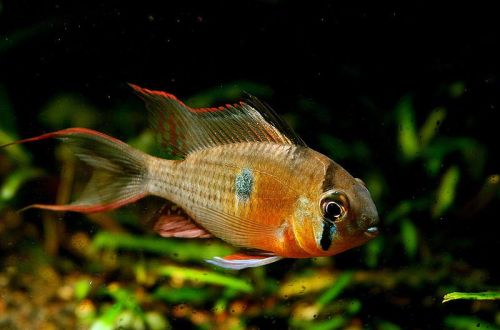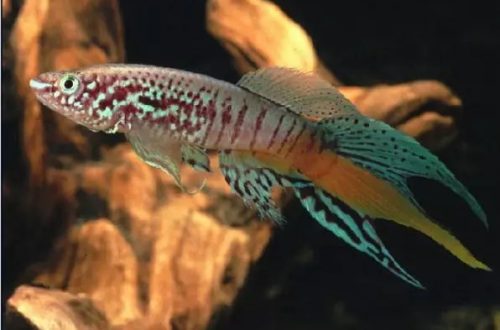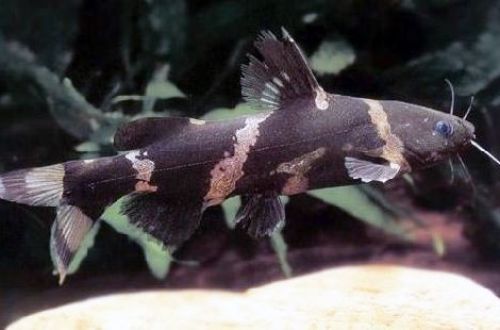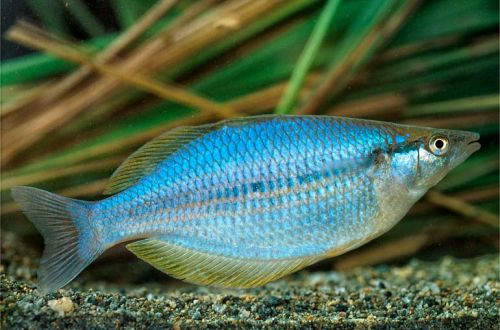
Bolivian butterfly
Bolivian Butterfly or Apistogramma altispinosus, scientific name Mikrogeophagus altispinosus, belongs to the Cichlidae family. Beautiful bright fish, compatible with other freshwater South American species of comparable size. Relatively easy to maintain and can be recommended to beginner aquarists.

Contents
Habitat
Comes from South America. It is considered endemic to the Madeira River basin, which flows through Bolivia and partly Brazil. Inhabits small slow-flowing tributaries, floodplain lakes with sandy and silty substrates.
Brief information:
- The volume of the aquarium – from 200 liters.
- Temperature – 20-28°C
- Value pH — 6.0–7.5
- Water hardness – 1–10 GH
- Substrate type – sandy
- Lighting – subdued
- Brackish water – no
- Water movement is weak
- The size of the fish is 7–8 cm.
- Food – small sinking food from a variety of products
- Temperament – peaceful
- Keeping in a group of 6-8 individuals
Description

Adults reach a length of up to 7-8 cm. Males are larger, look brighter and have elongated fins and tail. Coloring combines shades of red and yellow. The body pattern consists of a black dot in the middle and dark strokes on the head, one of which passes through the eye.
Food
In nature, they feed by sifting sand with their mouths in search of various organisms. In the home aquarium, sand also plays a key role in the feeding process. Feed sinking dry food with herbal supplements, such as flakes, pellets. If possible, frozen brine shrimp, daphnia, bloodworm pieces are served. Particles of food should not be large, the fish is not able to bite off, but swallows whole.
Maintenance and care, arrangement of the aquarium
The optimal size of the aquarium for a group of 6-8 fish starts from 200 liters. The design uses a sandy substrate (a must!), a few snags and aquatic plants arranged in patches to keep free patches on the bottom. The lighting is subdued. Taking into account the peculiarities of fish nutrition and low light, unpretentious shade-loving varieties or artificial analogues should be selected. A pair of large flat stones may serve as a spawning site in the future.
It is not as demanding on water quality as other relatives, and can forgive a few non-critical aquarist mistakes or forgetfulness regarding aquarium maintenance. The Bolivian butterfly prefers soft, slightly acidic water. Successful long-term management largely depends on the operation of the filtration system and the regularity of cleaning procedures, including: weekly replacement of part of the water (10–15% of the volume) with fresh water and the removal of organic waste (feed residues, excrement).
Behavior and Compatibility
Peaceful calm fish, prefers to be in a group of 6-8 individuals. Compatible with flocks of small characin species, which in nature are their constant companions and at the same time signal the absence of predators nearby. Large fish should be excluded.
Breeding / breeding
Apistogram altispinosa is quite amenable to breeding, provided that it is kept in a flock and in a favorable environment (we are talking about water quality). Best results are achieved in species tanks where there is no danger of predation by other fish.
With the onset of the mating season, the male and female form a pair. If the flock is large, then pairs can form two, three, etc.
The couple occupies a site at the bottom, the center of which becomes a flat stone or some kind of snag. The female lays eggs in batches, placing them in a row. The process is repeated several times. The incubation period lasts 2-3 days, the fry that appear for another week remain motionless and only then begin to swim freely. All this time, the parents stay close and protect their offspring.
Fish diseases
The main cause of diseases lies in the conditions of detention, if they go beyond the permissible range, then immunity suppression inevitably occurs and the fish becomes susceptible to various infections that are inevitably present in the environment. If the first suspicions arise that the fish is sick, the first step is to check the water parameters and the presence of dangerous concentrations of nitrogen cycle products. Restoration of normal/suitable conditions often promotes healing. However, in some cases, medical treatment is indispensable. Read more about symptoms and treatments in the Aquarium Fish Diseases section.





